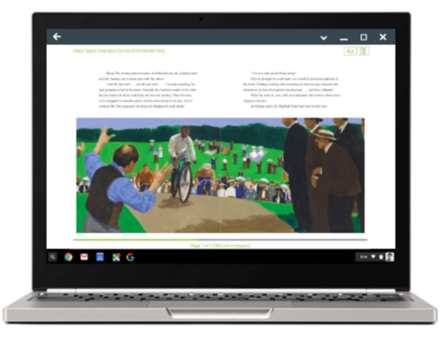Chromebooks are the most popular K-12 device out there with Chrome OS taking up more than 50% of the market, according to Futuresource Marketing. But being on top doesn’t mean that Chromebooks are without faults or bugs. For many schools, it’s been tough owning Chromebooks and discovering that certain apps aren’t available to students because they’re designed for Android.

Take the popular and free Open eBooks app, launched by Michelle Obama and the White House back in February; the comments section on the EdSurge article covering the release was littered with desperate pleas from educators for the app to be made available on Chromebooks, to no avail.
But all that’s about to change. Today, the company announced at Google I/O that Android apps will be coming to Chromebooks.
Android Apps, Meet Chromebooks
Up until this point, Android apps and Chrome apps have been completely separate ecosystems, meaning that apps designed for Android were not accessible on Chromebooks. But Rajen Sheth, Google’s Director of Product Management for Android and Chrome for Education, tells EdSurge that when Chromebooks began selling at a faster rate than Android devices in K-12 settings, he and his team began to rethink their strategy.
Why the division in the first place? Sheth explains that while Android "grew up" with the smartphone, Chromebooks began on the other end of the product spectrum: computers, when he and his team asked themselves, “How do we make computers better?"

Because Android apps will now be available on Chromebook, Sheth says the feature will benefit Chromebook users (and developers, too) in several ways. “The product team wanted make it such that users can take apps they're using, and use them across all devices,” he says. Here’s the breakdown:
- For teachers and students: They will now be able the run these apps offline, “which will make it easier with bandwidth constraints.” Additionally, students can now interact with touch-based apps—like the Open eBooks App (seen above) and whiteboarding app Explain Everything—on Chromebooks with touch capabilities.
- For administrators: For schools that have chosen Android for their web-based management console, everything can now be managed from App central console, Sheth says. Administrators can also curate the experience of what’s available for students, either preinstalling apps on devices, or calling out apps the Play store (including those shiny new Android apps) for students to download.
- For developers: Given this change, Android-only developers will now gain access to the Chromebook platform, instead of having to develop for two different environments.
Is This Feature Available Now?
Currently, a few apps are available through the App Runtime for Chrome program, including literacy app LightSail. Google doesn’t plan to launch the full collection of Android apps for Chromebooks on “supported devices” until the 2016-17 school year.
For those adventurous educators, however, Sheth reports that the feature will go into the “developer” channel next month. Translation: school administrators can take Chromebooks off the “stable” channel and go into the “developer” option to try out the new features early, if they so choose.
This is the second major Google K-12 announcement this week; yesterday, the company announced a new Classroom API feature supporting better coursework and gradebook integration.
For more info, check out the Google for Education blog.


